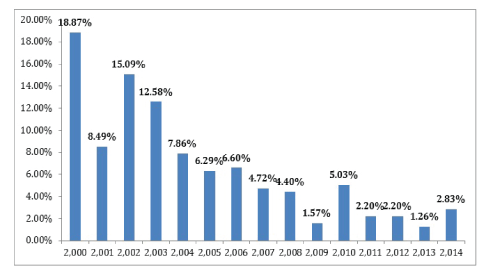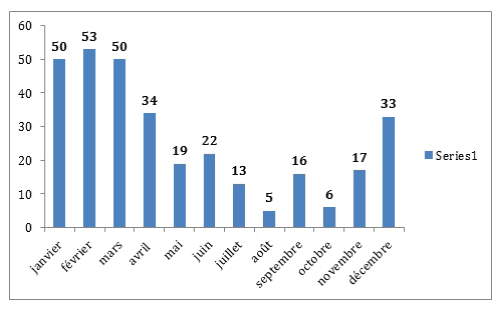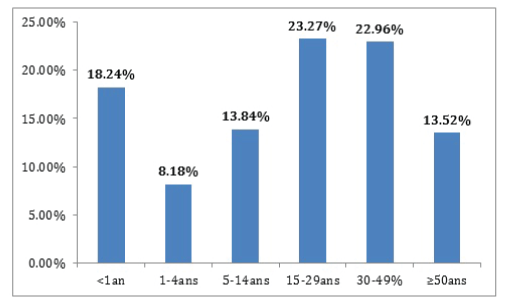Research Article Open Access
Epidemiological and Evolutionary Aspects of Streptococcus pneumoniae Meningitis in Burkina Faso
| Savadogo Mamoudou1*, Napon Christian2, Boushab Mohamed Boushab3, Zaongo Abraham1 and Kyéleme Nicole1 | |
| 1Department of Infectious Diseases at Chu-Yo, Burkina Faso | |
| 2Department of Neurology at Chu-Yo, Burkina Faso | |
| 3Department of Internal Medicine at Aioun Hospital Center, Mauritania | |
| *Corresponding Author : | Dr. Savadogo Mamoudou Department of Infectious Diseases Hospital Center University Yalgado Ouedraogo, Burkina Faso Tel: 70259154 E-mail: savadoma@gmail.com |
| Received: Feb 06, 2016 Accepted: Mar 04, 2016 Published: Mar 06, 2016 | |
| Citation: Mamoudou S, Christian N, Boushab BM, Abraham Z, Nicole K (2016) Epidemiological and Evolutionary Aspects of Streptococcus pneumoniae Meningitis in Burkina Faso. J Neuroinfect Dis 7:206. doi:10.4172/2314-7326.1000206 | |
| Copyright: © 2016 Mamoudou S, et al. This is an open-access article distributed under the terms of the Creative Commons Attribution License, which permits unrestricted use, distribution, and reproduction in any medium, provided the original author and source are credited. | |
Visit for more related articles at Journal of Neuroinfectious Diseases
Abstract
Aim: Pneumococcal meningitis remains a public health problem in Burkina Faso. The aim of our study was to describe the epidemiological and evolutionary aspects of pneumococcal meningitis. Patients and Methods: It was about a retrospective and descriptive study of the records of patients hospitalized for pneumococcal meningitis in the department of infectious diseases at CHU-YO, Burkina Faso during the period going from January 1st 2000 to December 31st 2014. Results: In 15 years, 318 cases were collected, representing a proportional morbidity of 5%. The sex ratio M/F was 1.2 and the average age was 24 years [44 days-70 years]. The majority (91%) of patients were from suburban areas of the city of Ouagadougou. Housewives, farmers and students were the most affected with 23%, 10% and 9%. The annual peaks of meningitis cases were recorded between January and April, which corresponds to the dry season. The evolution was fatal in 39.62%. The frequency of pneumococcal meningitis at CHU-YO remains relatively high with a heavy lethality. Hence the need to promote pneumococcal vaccination and strengthen the technical platform for an appropriate treatment of cases.
| Keywords |
| Meningitis; Streptococcus pneumoniae; Epidemiology; Evolutionary |
| Introduction |
| Bacterial meningitis remains a public health problem in developing countries [1]. In the countries located in the African meningitis belt, outbreaks were once common and the most responsible germ was Neisseria meningitidis serogroup A [1]. The introduction of conjugate anti-meningococcal vaccine A in 2010 [2] significantly reduced cases of meningococcal A meningitis and pneumococcal meningitis has become responsible for 20-30% of all purulent meningitis, with a very high morbidity and mortality [3,4]. This is currently the most worrying form in terms of therapeutic strategy [5]. Furthermore, with the HIV/ AIDS pandemics, pneumococcal meningitis is experiencing a resurgence of interest because it is one of the primary manifestations of HIV infection [5]. In Burkina Faso pneumococcal meningitis is second of bacterial meningitis with a case fatality between 40 and 70% [5,6]. Thus in the context of reducing its scope, Burkina Faso introduced the anti-pneumococcal vaccine into the expanded programme on immunization (EPI). At the service of infectious diseases of the Yalgado Ouedraogo University Hospital (CHU-YO), few studies have addressed this form of meningitis which is yet causing a heavy lethality. The reason why we have conducted this study is to help improve the management of cases, with the objective to describe the epidemiological and evolutionary characteristics of hospitalized cases in that service. |
| Patients and Methods |
| The study was conducted at the CHU-YO which is a third level referral center in Burkina Faso. Its purpose is the care, teaching and research. The infectious disease service is one of the clinical services of CHU-YO. It ensures the management of infectious diseases, including meningitis. |
| It was about retrospective with a descriptive oriented study over a period of fifteen (15) years, going from January 1st 2000 to December 31st 2014. The study population involved all cases of pneumococcal meningitis notified and hospitalized in the department of infectious diseases of the CHU-YO during the said period. Every patient admitted to the department of infectious diseases for pneumococcal meningitis, with information duly completed on the register and having clinical records was included. The patients hospitalized in the department of infectious diseases for pneumococcal meningitis and whose clinical cases are inoperable were not included. |
| A listing of standardized and validated collection enabled data collection. The data source being the record of each patient and the hospitalization register of the service of infectious diseases. |
| The collected data were entered and analyzed using EPI Info Version 3.5.1. |
| Results |
| Epidemiological aspects |
| During the 15 year study period, 318 cases have been collected corresponding to 5% of all admissions during the same period (318/6338 admissions). The following Figures 1 and 2 show the distribution of cases according to months and years. The average age of patients was 24 years with extremes of 0 and 70 years and the most affected age groups were: 15-29 years (23% of cases), 29-45 years (23% cases) and less than a year (18% of cases) (Figure 3). The sex ratio M/F was 1.2 but the infection affected mostly men (55%). The majority of our patients (91%) came from the suburban areas of the city of Ouagadougou. Housewives, farmers and students accounted respectively for 23%, 10% and 9% of patients. |
| Discussion |
| The prevalence of pneumococcal meningitis was 5% in the service of infectious diseases. This rate is comparable to what was reported by Mbelesso et al. in a hospital series in Central African Republic [7]. The average age of patients in our series was 24 years, with extremes of 44 days and 70 years. Our results are comparable to those of Savadogo et al. in Burkina who found an average age of 26 years, with extremes of 45 days and 78 years [5]. In their series in Senegal, Mangaet et al. found an average age of 44 years, while Mbelesso et al. had an average age of 34.7 years in Central African Republic [7]. |
| Evolving aspects |
| The average length of hospital stay was 07 days ± 6 with extremes between 0 and 28 days. The evolution was marked by 40% lethality (Table 1). |
| In our series, 60% of cases involved adults and the elderly people, while in the series of Konfe et al. children were the majority (72.49%) [8]. Males were predominant with (55%). Our results corroborate those of several authors in Burkina Faso and abroad [9-11]. The majority of our patients resided in urban areas as in the study of Manga et al. in Senegal [9]. The annual peak of meningitis cases were recorded during the period going from the months of January to April. The same observation was done by Mbelesso et al. in Central African Republic, by Seydi et al. in Senegal and by Djadou et al. in Togo [12]. This is explained by the fact that this period corresponds to the dry season; during this period, the translocation of the germs of pharyngeal mucosa into the blood is favored by drought and sandstorms (Harmattan) that dry and irritate the nasopharyngeal mucous membranes that lose their ability of defense against the infection [13]. The infections of the upper airways are also common in this season and the cool nights encourages promiscuity and transmission of airborne germs. In addition to these factors, we also have the weakness of the individual immunity and the level of nasopharyngeal portage of pneumococcus [13]. The average hospital stay was 7 days. Our results are comparable to those of Savadogo et al. who found an average of 08 days of hospitalization with extremes of 1-30 days [5]. This long period of hospitalization is probably related to the severity of pneumococcal infection requiring antibiotic therapy for an average of 10-14 days [14]. The fatality was high in our series as in most of the series, but compared to some African studies, the sequelae were less observed in our study [7,9,13,15,16]. |
| Conclusion |
| In Burkina Faso, pneumococcal meningitis remains a major public health problem. They mainly affect adults and older people living in urban and suburban areas. Despite advances in their management in Burkina Faso including free antibiotics, their evolution is still marked by a heavy lethality. The inclusion of pneumococcal vaccine in the expanded program on immunization offers a glimmer of hope in the fight against this dreaded disease. It is important to strengthen the technical facilities of hospitals for early diagnosis and appropriate treatment. The fight against this form of meningitis also involves the fight against the causes of immunosuppression, and the proper management of ENT (Ear, Nose and Throat) and pulmonary infections [17-21]. |
References
- https://extranet.who.int/iris/restricted/bitstream/10665/68997/1/WHO_CDS_CSR_ARO_2005.5_fre.pdf
- Alonso JM, Bertherat E, Perea W, Borrow R, Chanteau S, et al. (2006) African meningitis : the genomic strategies for surveillance , control and prevention . Bull Soc Pathol Exot 99: 404-408.
- Davis LE, Greenle JE (2003) Pneumococcal meningitis: antibiotics essential but insufficient. Brain 126: 1013-1014.
- Dao S, Goita D, Oumar AA, Diarra S, Traore S, et al. (2008) Epidemiological aspects of purulent meningitis in Mali. Afr Med Black 55: 514.
- Savadogo M, Ouedraogo A, Poda GA, Sondo A, Thiombiano R, et al. (2013) Bacterial meningitis in the University Hospital Yalgado Ouédraogo in non-epidemic period (Ouagadougou, Burkina Faso). Burkina Med.
- Yahogo I (2013) Study of acute meningitis in the University Hospital Yalgado Ouedraogo ( Burkina Faso ) from 2010 to 2013.
- Mbelesso P, Tatangba-Bakozo A, Fiko uma V (2006) Bacterial meningitis in adults in Central African hospital . Bull Soc Pathol Exot 99: 261-263.
- Konfe AK (2010) Instead of pneumococcal bacterial purulent meningitis collected in 2010 and 2011 in Burkina Faso Ouagadougou University 69.
- Manga NM, Ndour CT, Diop SA, Ka-Sall R, Dia NM, et al. (2008) The purulent meningitis Streptococcus pneumoniae in adults in Dakar. Too Med 68: 625-628.
- Djé A (2006) Epidemiological aspects , biological and evolutionary acute bacterial meningitis in Ouagadougou in 2006. Thesis Pharmacy , No. 070 , University of Ouagadougou 66.
- Ouangraoua SAS (2008) epidemiological and biological aspects of 518 cases collected from acute bacterial meningitis during the epidemic of 2007 in 12 health districts BURKINA FASO . Thesis Pharmacy, No. 111, 92 University of Ouagadougou.
- Djadou K, Madjikoraim M, Gbati T, Bamazi P (1999) Epidemic cerebrospinal meningitis in Dapaong ( Togo ) from December 1996 to April 1997. MédAfr Black 46: 554- 560.
- Nicolas P (2012) Outbreaks of meningococcal meningitis in the meningitis belt (1995-2011) and introduction of the meningococcal A conjugate. Tropical Medicine and HEALTH 22: 246-258.
- OMS (2011) Technical Guide for Integrated Disease Surveillance and Response ( IDSR ) in the African region in February.
- Thabet F, Tilouche S, Tabarki B, Amri F, Guediche MN, et al. (2007) Mortality of pneumococcal meningitis in children: factors about prognosis of 73 cases in university hospitals of central Tunisia 14: 334-337.
- Faye-Kette H, Doukou ES, Boni C, Akoua-Koffi C, Diallo-Toure K, et al. (2003) Community officers purulent meningitis in children: epidemiological trend in Abidjan , Ivory Coast , e1995 of the year 2000.Bull Soc Pathol Exot 96: 313-316.
- Seydi M, Soumare M, Sow AI, Ndour CT, Dia NM, et al. (2002) Clinical, bacteriological and therapeutic of cerebro-spinal meningitis in Dakar in 1999. Too Med 62: 137-140.
- Sanou I (2004) Study of bacterial meningitis in epidemic and interepidemic phase in Burkina Faso from 2000 to 2003. Single PhD Thesis , No. 928, UFR / SVT University of Ouagadougou 176.
- Labreze L, Faure E (2002) Meningitis Impact of Physician -Dossier No554-02 practitioner / 11/2001 . Validation December 2001 Last Updated September.
- Brisou P, Chamouillit JM, Gaillard T, Muzellec Y (2004) pneumococcal Medico- Surgical Encyclopaedia 4-10.
- Zongo M (2015) Meningitis in children's pneumococcal at University Hospital Pediatric Charles De Gaulle From Ouagadougou: epidemiological, clinical, therapeutic and evolutionary. N088 medical thesis, University of Ouagadougou 127.
Tables and Figures at a glance
| Table 1 |
Figures at a glance
 |
 |
 |
| Figure 1 | Figure 2 | Figure 3 |
Relevant Topics
- Bacteria Induced Neuropathies
- Blood-brain barrier
- Brain Infection
- Cerebral Spinal Fluid
- Encephalitis
- Fungal Infection
- Infectious Disease in Children
- Neuro-HIV and Bacterial Infection
- Neuro-Infections Induced Autoimmune Disorders
- Neurocystercercosis
- Neurocysticercosis
- Neuroepidemiology
- Neuroinfectious Agents
- Neuroinflammation
- Neurosyphilis
- Neurotropic viruses
- Neurovirology
- Rare Infectious Disease
- Toxoplasmosis
- Viral Infection
Recommended Journals
Article Tools
Article Usage
- Total views: 10624
- [From(publication date):
March-2016 - Apr 10, 2025] - Breakdown by view type
- HTML page views : 9659
- PDF downloads : 965
